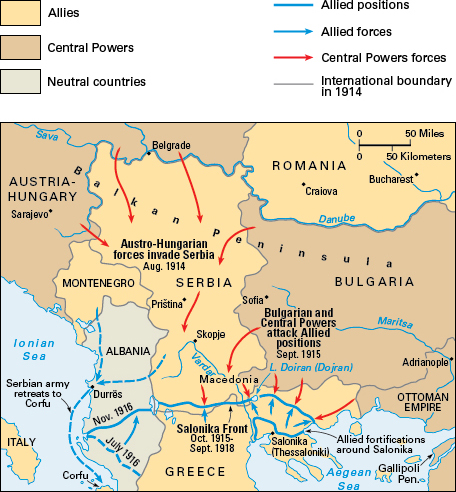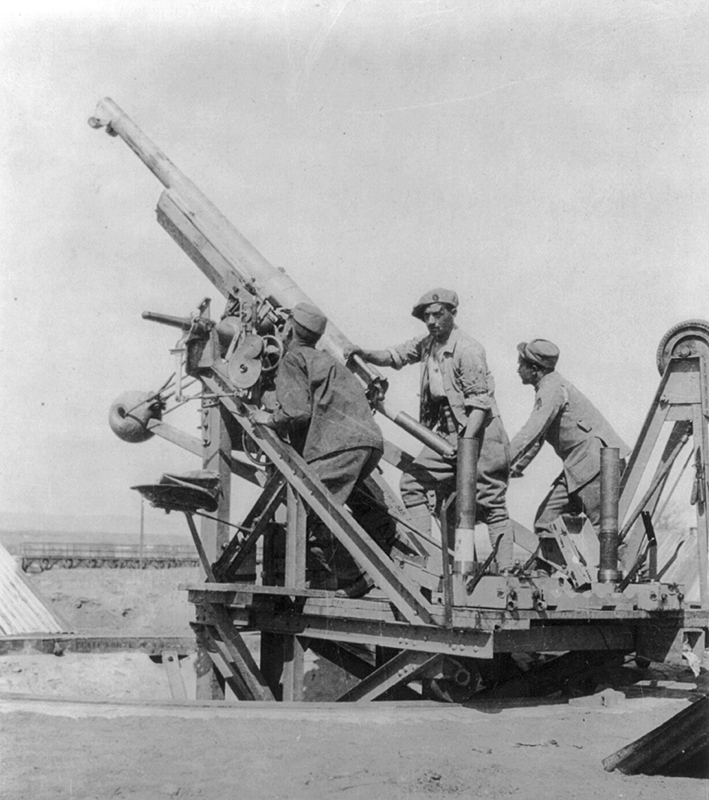Salonika Front was a battlefront in the Balkan Peninsula of southeastern Europe during World War I (1914-1918). Salonika—now called Thessaloniki —is one of Greece’s largest cities and a major port on the Aegean Sea . During World War I, the Allies created a large base at Salonika. From there, they supplied and reinforced troops fighting mainly against Bulgaria . The Salonika Front was just one of several battlefronts during World War I. It is sometimes called the Balkan Front, as well as the Macedonian Front, because it ran through the historic region of Macedonia. At that time, the region was divided between Bulgaria, Greece, and Serbia.

Background.
Austria-Hungary , along with Germany and the Ottoman Empire , made up the Central Powers in World War I. In August 1914, Austro-Hungarian forces launched the first of several invasions of Serbia . In September 1915, Bulgaria allied with the Central Powers. It joined the attack on Serbia in October.
Greece, Bulgaria’s neighbor to the south, remained neutral. Greek Prime Minister Eleutherios Venizelos sympathized with the Allied cause led by France , Russia , and the United Kingdom . Greece’s King Constantine I , however, strongly supported the Central Powers. Despite Greece’s neutrality, Allied troops—mainly British and French—were invited to land in Salonika. The Allies intended to help Serbia, but the Bulgarian army blocked their way. The Central Powers overran Serbia in November. Part of the Serbian army escaped, however, into Albania and Montenegro. From ports on the Adriatic Sea, Allied ships evacuated them to the Greek island of Corfu.
The front.
Allied forces engaged the Bulgarians in small battles north of Salonika in late 1915. The Allies then fortified Salonika, surrounding it with trenches, barbed wire, and other defenses. In mid-1916, Bulgarian troops, supported by Austro-Hungarian and German units, invaded northern Greece. Allied forces, which now included Italian , Russian, and Serbian troops, stopped the Bulgarian invasion.

Beginning in March 1917, the Allies launched numerous assaults on Bulgarian positions, but they made little progress. The Salonika Front then settled into a static (nonmoving) line of trench systems that stretched across Albania , southern Serbia, and northern Greece. Particularly heavy fighting occurred along the Vardar River and Lake Doiran (or Dojran).
In June 1917, Greece’s King Constantine was forced to abdicate (give up the throne). Greece then officially entered the war on the Allied side. Thousands of Greek troops joined the Allies at their Salonika base. In September 1918, the Greeks and other Allied forces made large gains against the Bulgarians. With the Central Powers now losing on all fronts, the Bulgarians signed an armistice (agreement to end fighting) on September 29. Fighting stopped on the Salonika Front the next day. The entire war ended on November 11.
Aftermath.
The Allied effort at Salonika played a large part in forcing Bulgaria to surrender. However, it also drew essential Allied soldiers and supplies away from other fronts. Tens of thousands of soldiers died fighting on the Salonika Front. Malaria and influenza killed thousands more.
